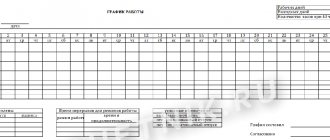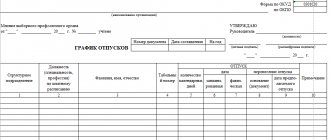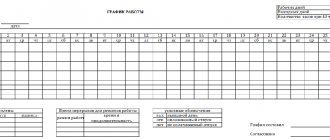When does a shift work schedule apply?
A shift schedule is a fairly common phenomenon. It is used in a wide variety of industries, most often in companies with a continuous round-the-clock production cycle - the need for its use here is due to the fact that equipment downtime is unacceptable, because they lead to system failures and significant financial losses. But regular, timely replacement of personnel leads to an increase in the volume of output, improved labor productivity and, as a result, greater profits.
Also, a shift schedule is common in other areas, for example, in medical institutions, security structures, firefighters, gas services, rail and transport transportation, air travel, etc.
Shift work schedule: requirements imposed by the legislation of the Russian Federation
Employee work schedule - example
Shift work is used when the production process time is longer than the allowable working time of individual employees, and when the need to work without interruption is caused by the specific nature of the equipment, product or service (for example, an iron foundry, gas station, etc.).
The most commonly used schedule is 2/2 or 3/3. Principles to consider when assigning shifts:
- If the working day is twelve hours, then the employee cannot be assigned more than forty working hours per week. In this case, the time of continuous rest cannot be less than forty-two hours per week.
- The night shift lasts an hour less than the day shift.
- There is an extra charge for night hours.
- Before a non-working holiday, the shift becomes an hour shorter or this hour is paid at double the rate.
- It is prohibited to put two shifts in a row. The shift can only be extended in an emergency.
- If the shift lasts twenty-four hours, then it is necessary to provide the employee with rest of the same duration or more.
- The law does not establish a maximum shift duration for all employees, only for certain categories (for example, railway workers, crew on ships, etc.).
- In a three-shift system, shifts alternate every week.
- Each employee must work the same number of hours in the same amount of time.
- If more than half of the shift is at night, it should be reduced by one hour.
Why do you need a shift schedule?
The shift schedule is one of the most important internal documents of the company.
Based on the schedule, employees' working hours are recorded and their wages are subsequently calculated.
Thus, it relates not only to methods of organizing work at an enterprise, but is also a serious accounting form.
We must not forget that if the company provides for shift work, then the availability of the schedule is necessarily checked by government supervisory structures (for example, the labor inspectorate and the tax service). The absence of this document may result in the imposition of an administrative penalty on the enterprise and its management in the form of a fairly large fine.
How to count hours worked with a flexible schedule
With a flexible schedule, working time tracking is required. That is, all the time actually worked by the employee according to such a schedule must be reflected by the employer in the time sheet. A flexible schedule may involve different numbers of hours worked on different days, for example, an employee may work 8 hours on one day and 7 or 9 hours on another. Therefore, it is necessary to keep a summary record of working time for a certain accounting period. This is confirmed by Rostrud specialists in explanations on the website “Onlineinspektsiya.rf”.
The procedure for introducing such accounting is established by the internal labor regulations (Part Art. 102, Art. 104 of the Labor Code of the Russian Federation).
It’s easy to keep track of hours worked in the Kontur.Personnel program
Legislative regulation, mandatory conditions
The shift schedule is regulated by law, namely Art. 372 of the Labor Code of the Russian Federation (Part 3 of Article 103 of the Labor Code of the Russian Federation). When introducing it into an organization, it is required to strictly comply with the norms and conditions of the above section of the Labor Code of the Russian Federation.
The rules for operating in this mode are spelled out here quite thoroughly and clearly. There is no point in listing them in this article, but some simply need to be emphasized:
- the weekly working hours in the sum of all shifts should not exceed forty hours;
- every shift people should be given a lunch break (its duration is determined individually - from 30 minutes to 2 hours);
- employees must be provided with uninterrupted rest for 42 hours every week;
- the employer is obliged to indicate to employees that it is inadmissible for them to perform their duties in two shifts in a row (except in emergency cases) - and strictly monitor this.
If an organization feels the need to use a shift schedule for different categories (positions) of employees, then for each of them the duration of the shift can be determined separately (such situations occur in transport companies - one work mode is used for drivers, another for dispatchers, and another for service personnel). third).
When creating a schedule, one more important point should be taken into account - if most of it falls at night, then the shift should automatically be reduced by an hour.
All other working conditions must also comply with the law, including in matters relating to the payment of wages, provision of sick leave, vacation, etc.
How is the document regulated by the Labor Code of the Russian Federation?
The shift schedule involves dividing employees (workers and other personnel) into equal groups. Each group, or shift, works a certain working time so that there are no violations of the articles of the Labor Code of the Russian Federation. This applies to:
- Article 91 of the Labor Code of the Russian Federation, according to which working hours should not exceed 40 hours per week ;
- Article 108 of the Labor Code of the Russian Federation, which indicates the need for a break for rest and nutrition (from 30 minutes to 2 hours);
- Article 110 of the Labor Code of the Russian Federation, which describes the time for weekly continuous leave (at least 42 hours).
The concept of “shift work” is regulated by Article 103 of the Labor Code of the Russian Federation. It is carried out according to the approved timesheet. In this case, it is not allowed for an employee to perform his job duties for two shifts in a row.
Detailed information about the preparation, approval and other nuances of the document is presented in the video:
What is not considered a shift schedule
Some personnel officers mistakenly believe that the work schedule is a day after two/three, two days after two, etc., refers to shift work. If you carefully read the labor legislation of the Russian Federation, it turns out that this is not so. A group of workers, performing their job duties during one day and being replaced by others the next day, works in a regime fixed within the enterprise, but there is no clear procedure for developing such a regime, its coordination and approval.
How to set up a flexible schedule
Working hours are a mandatory condition of an employment contract. A flexible schedule is one of the possible options (paragraph 2, part 6, article 57 of the Labor Code of the Russian Federation, article 100 of the Labor Code of the Russian Federation), in which the beginning, end or total duration of the working day is determined by agreement of the parties. To set up a flexible schedule, you need:
- fix it in the employment contract or in an additional agreement to it (Article of the Labor Code of the Russian Federation);
- issue an order in free form establishing a flexible schedule and familiarize the employee with it against signature.
Example
The text of the condition on a flexible work schedule (with a constant working day) in an employment contract may look like this: “The employee is provided with a flexible working time regime, the elements of which are:
- working day duration __ hours;
- start time: from ___ to ___ or from ___ to ___;
- fixed time: from ___ to ___ or from ___ to ____;
- break for rest and food: from ___ to ____ or from ___ to ___ for ___ duration;
- Closing time: from ___ to ___ or from ___ to ___.
The choice of the start and end time of work during these periods is determined by the employee independently, taking into account production needs.”
Some points regarding payment
The calculation of remuneration for a shift schedule is somewhat different from the standard one. The specificity here is that the number of working hours according to the regime established at the enterprise may differ from the norm established by law, both upward and downward (the so-called planned overtime or underwork).
To ensure that there are no errors in salary calculations, at the end of the accounting period, the following parameters should be reconciled: the number of working hours in accordance with the norm and their number, based on real indicators. If, when comparing, the second indicator is greater than the first, you will need to calculate and pay the employee extra for overtime.
If an employee’s shift falls on a day off, then it is paid as usual (this is justified by the peculiarities of the shift conditions). If he is forced to work on a holiday (state non-working days are specified in the Labor Code of the Russian Federation), then he must be paid at the appropriate standard rate, i.e. in double size.
What is a flexible schedule
A flexible schedule, or flexible working hours, involves self-regulation of the start, end and total duration of a work shift or the length of the working day.
That is, an employee can start and finish work at different times on different days. In this case, the duration of the working day can be either constant on all working days or different. Note that a flexible schedule is not complete self-regulation of the beginning, end or total duration of the working day, but only partial. First, the employee and the employer come to a written agreement on the limits within which the employee has the right to independently determine the start or end time of the working day and its duration. And then he arranges his own working day, based on the agreed limits (Article 102 of the Labor Code of the Russian Federation).
Until 2021, the provisions of the “Recommendations for the application of flexible working time regimes in enterprises, institutions and organizations of sectors of the national economy” were used (approved by Resolution of the USSR State Committee for Labor No. 162, All-Union Central Council of Trade Unions No. 12–55 of May 30, 1985). According to them, with such a schedule the following were determined simultaneously:
- fixed time - a period of time when an employee works while at the workplace;
- flexible time within which the employee has the right to start and finish work at his own discretion.
Now, the allocation of a period of fixed work time is not necessary, since the document has lost force.
On a note. What is a moving schedule?
Employers sometimes confuse the concepts of flexible and flexible working, but it is important to understand that they are not the same thing.
A sliding schedule is the provision of days off according to a changing schedule (Article 100 of the Labor Code of the Russian Federation). That is, weekends fall on different days in different weeks. For example, if an organization works seven days a week, employees may be given days off in one week - Monday and Tuesday, in the second - Wednesday and Thursday, in the third - Friday and Saturday, etc.
A sliding schedule is established upon hiring by an employment contract, and for an existing employee - by an additional agreement to the employment contract. At the same time, an order is issued in free form, and the employee must be familiarized with it and signed.
Note that the employer will have to draw up work schedules for a week or month in advance and ensure that employees familiarize themselves with the schedule upon signature. This way, before the start of the work week/month, they will understand which days are weekends for them and which are working days. The minimum possible period within which employees need to be familiarized is fixed in the employment contract or in the employer’s local regulatory act, for example, in the internal labor regulations.
If the period for familiarization with the schedule is established by a certain local regulatory act, this must be indicated in the employment contract.
Consolidating the work order
If the management of an enterprise decides to use a shift work schedule, it must enshrine this norm in its accounting policies, or more precisely, in its Internal Regulations.
If the company has a trade union cell, these Rules, including those regarding shift work, must be approved by its representative. A five-day period is allotted for interaction with the trade union - during this period, trade unionists must either approve the Rules presented to them or challenge them with evidence.
It is also possible to establish the use of a shift schedule in a collective agreement.
In addition to the internal regulations and the collective agreement, the clause on shift work must be spelled out in sections of individual employment contracts with employees, indicating the number of hours per shift and other parameters.
How to register an employee's transfer to another job shift?
author of the answer,
Question
The company operates a three-shift work schedule. Shift schedules are approved at the end of the year immediately for the next year. The employment contract stipulates that the employee is assigned a full working day with shift work in accordance with shift schedules. Now there is a need to transfer an employee from shift A to shift B.
Will it be enough to notify the employee 1 month in advance about the shift change and familiarize him with the shift schedule for shift B?
Answer
If the employment contract states that the employee is assigned a full working day with shift work in accordance with shift schedules, and a specific shift is not specified, it is enough to familiarize him with the new shift schedule against signature 1 month before it comes into force (notification in this case is not required).
Rationale
In accordance with Art. 56 of the Labor Code of the Russian Federation, an employment contract is an agreement between an employer and an employee
, in accordance with which the employer undertakes to provide the employee with work for a specified labor function, to provide working conditions provided for by labor legislation and other regulatory legal acts containing labor law norms, a collective agreement, agreements, local regulations and this agreement, in a timely manner and in full pay the employee wages, and the employee undertakes to personally perform the labor function determined by this agreement in the interests, under the management and control of the employer, to comply with the internal labor regulations in force for this employer.
If for a certain employee the working and rest time regime differs from the general rules in force for a given employer, then it must be specified in the employment contract. This requirement is fixed in Art. 57 Labor Code of the Russian Federation.
In accordance with the requirements of Art. 72 of the Labor Code of the Russian Federation, it is possible to change the terms of an employment contract (including working hours) by agreement of the parties or
changing the terms of the employment contract by the employer in accordance with Art. 74 of the Labor Code of the Russian Federation in case of changes in organizational or technological working conditions.
However, in the case under consideration, based on the conditions of the issue, the employer legally indicated in the employment contract the employee’s work schedule in accordance with the shift work schedule
.
At the same time, if the employment contract does not specify the shift on which the employee is involved in work - no changes to the terms of the employment contract in terms of working hours are required - it is enough for the employee to familiarize himself with the new shift schedule against his signature 1 month before it comes into force.
| She answered the question: I.V. Tarasova, leading expert at Consultant + Askon |
The process of creating a shift schedule
The first practical stage in implementing a shift schedule is an order for its creation, issued on behalf of the director of the organization. It contains instructions to create a shift schedule, period, responsible person and other necessary information.
Sample order for approval of shift schedule
Next comes the actual preparation of the document. The interests of the employer and employee must be taken into account here.
The schedule is formed in advance - at least thirty days before the start of the shift.
Each employee mentioned in the document must be familiarized with it against signature. Thus, he indicates that he agrees with this mode of operation.
After development, coordination and final approval, the schedule will be binding both for the management of the enterprise and for the employees designated in it.
How to arrange a shift schedule in accordance with the Labor Code?
Elena Kozhemyakina, Managing Partner of the BLS law firm.
Supermarket, pharmacy, manufacturing, etc. – Shift work is used in many industries. And now you need to “make up” a new schedule: for some it will not change, but for others a different “schedule” will appear. And we also need to familiarize the staff; several people got sick, went on vacation, and some don’t agree. What to do and how to change the schedule in accordance with the law?
One of the large enterprises planned to optimize the work of a personnel administrator. During the process, it became clear that changes needed to be made to the company's shift schedule. This question put our client in a quandary. Let's turn to labor legislation and practice.
It's easy to get stuck. The Labor Code of the Russian Federation says nothing about adjusting the shift schedule. According to established practice, this is done no less than 1 month before the expected date of changes. Or it is possible to create a new schedule, but in any case, it is necessary to familiarize the staff with it a month in advance against signature. The most difficult situation is if a person is on vacation or sick leave. How to get his signature? And when he returns, he may disagree and say: “You offer a new schedule 2 weeks before joining, and I can refuse.”
Unfortunately, the law does not explain exactly how long in advance you must inform an employee of the changes in the event of his temporary absence. However, it is you who bear the risks: without receiving his signature a month before the set date, you will de facto not be able to implement the new schedule, and the employee will defend the previous work schedule. What to do in such a situation?
We recommend that the information be accurately specified in the employment contract and the Internal Labor Regulations (ILR).
Namely: how many shifts per day, when they start and end, the rotation order. After all, if you do not have time to inform the employee about the changes in time, you will have to solve not the issue of the schedule, but negotiate with the person.
The best option: indicate in the employment contract that the person works in accordance with the shift schedule, and if he is not familiar with it, then he is obliged to go to work on a certain date. In this way, you establish the employee’s obligation to comply with the schedule, which will be the main one, and at the same time clarify that another mode of work is possible. Then, if he does not come out in accordance with the new “schedule,” he will no longer have any reason to manipulate.
For example, a recent question from our client . “We need to sign a new shift schedule from November 1 with a group of 40 employees. But two of them are on sick leave and should return on November 10. What should a company do in the period from November 1 to November 10?”
The issue can be resolved with the help of existing employees, who are also indicated in this shift schedule.
But we must remember: when involving them additionally, we are talking about overtime work or work on days off.
Let's give an example of organizing substitution . The company operates in 2 shifts. One group of employees completes their shift, and one of the employees does not go to the second shift due to illness. You can offer one of those who worked “in the morning” to work overtime and stay for the second shift until you provide a replacement.
However, this option has limitations. Art. 99 of the Labor Code of the Russian Federation reminds that overtime work should not exceed 4 hours for 2 days in a row and 120 hours per year. So you can attract him only in order to hire a “full-fledged replacement”. That is, you will have to urgently find and ask an employee who is on vacation according to the shift schedule to come out on his day off. And, given that work for 2 shifts in a row is not allowed, according to Art. 103 of the Labor Code of the Russian Federation, you can only hire an employee on a day off who is already on the 2nd or 3rd day of rest according to the schedule.
Let us also announce an even more interesting development of events from practice.
When there are not enough employees, you can attract them from your other departments/stores. You will enter into employment contracts with them, and these may be permanent part-time contracts for periodic work.
You are simply “giving out a cry” to those who want to earn extra money. These will always be there, you just need to post replacement schedules. It's convenient and effective for everyone. You get a stable budget, no overtime or problems with overtime, as well as good motivation, and your employees get a real opportunity to earn extra money.
Is it possible to change the information in it?
Changes are allowed to the approved shift schedule, but only as a last resort and in compliance with certain rules.
Firstly, if changes occur at the initiative of the employer, he must notify his subordinates in advance about them and obtain their written consent - without them, making changes legally will be problematic.
If one of the employees asks to change the shift schedule, he must draw up a special application addressed to the manager. The application must indicate the reasons for the request (it must be respectful with appropriate written justifications), then the consent of the other employees to whom the document concerns must be obtained. If colleagues and management managed to reach a compromise, a new order is formed, on the basis of which the necessary adjustments are made to the schedule.
How to coordinate with employees
The shift schedule must be agreed upon with employees in advance, as mentioned above - no later than thirty days before the start of the first shift.
Signatures of consent can be placed directly on the schedule itself, or you can make a separate sheet for this.
If the second option is chosen, then you need to make a table on the approval sheet, enter all the employees there and collect their autographs (with the date they were signed). This document will be an official attachment to the shift schedule.
Features of the formation of a shift schedule, general information
If you are tasked with creating a shift schedule, and you have no idea how exactly it is formed, read our recommendations - they will give you an accurate idea of this document. Also check out the example of filling it out - based on it you can easily create your own form.
Before moving on to a detailed description of the schedule, we provide general information about the document. Let's start with the fact that there is no unified form of the schedule. This means that it can be written in free form or according to the model approved in the accounting policy of the organization. In this case, the method of forming the form must be reflected in the company’s regulations.
Regardless of which scheduling method is chosen, the document must contain a number of mandatory data:
- Company details;
- information about the place and time of compilation;
- the schedule itself.
The form must be certified by several persons. Firstly, by those employees in respect of whom it was formed, secondly, by the head of a structural unit and, thirdly, by the director of the company.
It is not necessary to certify the form with a seal - this should be done only when such a condition is in the company’s local documentation.
The schedule can be drawn up on a simple blank sheet of paper (preferably A4 format) or on the organization’s letterhead (if such a requirement is established by management). You can write it manually or on a computer (with mandatory subsequent printing).
How to take into account the shift schedule
All schedules developed at the enterprise are subject to mandatory registration in the appropriate accounting journal. After carrying out all the necessary procedures with them (development, coordination, approval, familiarization), they are transferred for storage to the company’s HR department. Here they are filed in a separate folder with other similar documents. Access to the place of their detention for unauthorized people should be limited.
The duration of their storage is indicated either in local acts of the organization, or is established by the legislation of the Russian Federation (but not less than five years). After this period has expired, the schedules can be disposed of in accordance with the procedure established by law.






